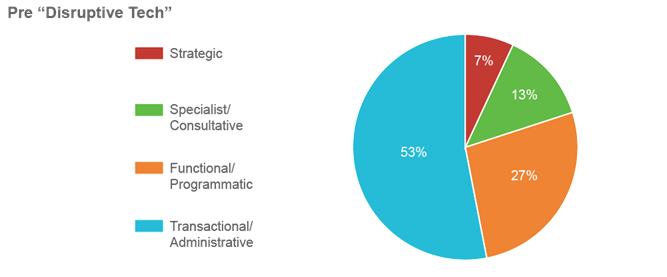
This is the third article in a series of three focused on intelligent automation in today’s global business services.
Article 1: Global Business Services: The Evolving Standard for Global Service Delivery
Article 2: Intelligent Automation on the Horizon
As described in prior articles, “Global Business Services: The Evolving Standard for Global Service Delivery” and “Intelligent Automation on the Horizon,” three intelligent automation technologies are quickly being adapted to shared services solutions: Robotic Process Automation (RPA), Virtual Agents (VA), and Artificial Intelligence (AI). What appeared to be a gradual testing of the waters a few years ago has turned into a tidal wave of new solutions that are yielding surprising results. These technologies are no longer “on the horizon,” they are “here.” The questions we face are: (1) what is their potential impact on global business services (GBS), and (2) what should GBS executives be doing to prepare for them?
The Impact of RPA, VA, and AI Technologies
If you want to better understand the potential impact of the new intelligent automation technologies on GBS, just revisit all the decisions you made, or are thinking of making, to reduce labor costs. Let’s take a look at a few of these:
- Business Process Outsourcing (BPO) Decisions: For years companies have turned to BPO solution providers to lower the cost associated with standard, rule-based, repetitive processes. BPO solution providers, in turn, moved their service centers to developing countries where labor costs were lower. But what if the processes involved could be automated via RPA bots? This would either reduce the need to outsource selected processes or would impact the decision as to which BPO service provider to use, insofar as many providers are working to adapt the new intelligent automation technologies to their solution offerings.
- ERP Decisions: RPA’s ability to automate repetitive process transactions has multiple ERP implications. For example, one of the daunting tasks facing GBS executives is whether to move to a single-instance ERP solution or deal with the headaches of multiple ERP solutions across their global footprint. RPA solutions can side step this decision and serve as an unsophisticated “integration” tool. If your customer service representatives are currently logging onto one system and then using that data to input into another system, it may be cheaper to automate this activity via RPA rather than to move to a single ERP solution.
- Support Service Location Decisions: Typically, GBS support hubs have been located in specific countries or key regions in order to utilize local language employees and provide service availability in local time zones. But, what if VAs could handle 30% of the call volume, immediately translate any language, and do this on a 24/7 basis? Country and regional service hubs could be located closer to the company’s headquarters where technology solutions may be easier to manage, quality control and intellectual property and privacy issues might be better managed, and COE services would be more readily available.
- Location of COEs Decisions: The same can be said about COEs. These have typically been located close to the company’s headquarters where service specialists are available. In those instances where AI solutions are able to perform complex analytical tasks, some or many of these tasks can be performed anywhere in the world.
If all of these disruptive impacts are taken into consideration, the GBS global footprint we presented earlier might look like the figure below in the near future. Services currently located in foreign transaction centers and regional service hubs might be moved back to the company’s headquarters or located wherever RPA, VA, and AI talent is available.

Based upon the results achieved to date, plus the potential range of future applications, we believe the cost-saving implications of intelligent automation technologies are impressive. In fact, we estimate that RPA solutions are capable of automating as much as 70% of the transactional/administrative work typically performed by the GBS organization. Similarly, we anticipate that VA and AI solutions will eventually automate up to 65% of the functional/programmatic work and 35% of the specialist/consultative work performed by COEs and local support. The cumulative impacts of these reductions have the potential to reduce total GBS costs by nearly 50% when fully implemented.

The potential labor-savings impact of these technologies is staggering. On a company level, they have the ability to reduce costs, improve service, and cement your competitive position. On a global scale, it is estimated that they have the potential to replace more than 100 million knowledge workers or nearly one-third of the world’s knowledge-based jobs. These include jobs that require decision making, judgment, and human interaction and will impact everything from administrative clerks to middle management. No matter how we choose to adapt to this new world order, the introduction of these technologies is likely to be one of the 21st century’s primary social challenges. Some of the questions we face include:
- What do we do with the displaced workers? Is re-training to higher-level activities feasible? Are there enough higher-level activities to accommodate our displaced knowledge workers?
- Is there enough digital talent to go around? Are our universities and local colleges training students in the right skills? Where are the deep pools of digital talent in the world today? How do we ensure access to this talent?
- Where do we locate our intelligent automation COEs within our companies? Within the world?
- Do we move our corporate intelligent automation COE to be near digital labor pools or attract digital labor to our COEs?
- How do these technologies impact our global GBS labor footprint? Where should work be performed to achieve maximum cost reduction and efficiency?
What You Should Do To Prepare
Preparing to harness the impact of any disruptive technology is always problematic. Move too soon and you are on the “bleeding edge” of technology. Move too late and you may lose your competitive advantage. The one thing you cannot do is ignore it. The table below summarizes our view of where each of the three technologies is likely to impact GBS operations and what the potential impact is.

Steps You Should Take
Below are some steps you might consider in moving forward. They are based on our experience in guiding companies through the adoption of intelligent automation technologies into their GBS organization.
1. Assess for Opportunities
If you have not already done so, designate a digital leader or team to assess intelligent automation technologies and understand their potential impact on your businesses.
- Conduct strategic sessions to design holistic GBS Models, utilizing intelligent automation technologies and a new “work type”
- Conduct process mapping workshops to hone in on a short list of “high-impact” business processes
- Conduct market research and document the vendor landscape
2. Build the Case
Document the potential benefit of applying intelligent automation technologies and obtain management support for moving forward.
-
Utilize work activity tools with intelligent automation (RPA, VA, and AI) as a new “work type.” Measure work activities and determine specific work that can be automated
-
Conduct cost-benefit analysis and develop resource forecasts by role
-
Evaluate associated risks
-
Align your approach with your strategic objectives, your five-year IT road map, and your business priorities
3. Prepare your data
All of the intelligent automation solutions are reliant on clean and well-structured data. Absence of this can lead to more problems than fixes. Questions around the ownership and use of data can also impede the process.
-
Determine what data will be needed to support a pilot or initial IA project
-
Performa review of data eliminating duplicate, outdated, or erroneous information
-
Ensure data is coming from one source of truth
-
Design a data governance model to determine what data may be used, and for what purposes. Designate a data governor to rule on data issues
4. Select the Vendor and Pilot
Test the waters. Select a pilot GBS business process where favorable results are likely to be more readily achieved. Use the pilot to build support and better understand the degree of disruption inherent in these new technologies.
-
Create an RFP with detailed requirements and select a software provider
-
Pilot use cases selected in one function (keep it simple)
-
Refine and finalize the earlier business case
-
Conduct contract negotiations
5. Implement Solution
If you selected your pilot business process appropriately, this should take three to nine weeks.
-
Create and manage the implementation plan
-
Create and manage the project plan
-
Develop and implement change management strategies and tactics
-
Navigate roles, responsibilities, and key stakeholder engagement
6. Manage Intelligent Automation Lifecycle
Move from the “project” environment to an ongoing “operations” environment. Make sure it sticks.
-
Create an intelligent automation COE to assess upcoming, long-term strategic decisions that are likely to be impacted by intelligent automation technologies (BPO decisions, ERP decisions, service support decisions, location decisions, etc.)
-
Determine your new operating model, governance, and process prioritization
-
Manage the ongoing communication and change management
Summary
Regardless of your perspective, you can’t ignore that these new technologies are going to fundamentally affect how GBS organizations deliver their services in the future. Whether they represent a problem or an opportunity, it is better to face them now rather than postpone the inevitable. By effectively assessing your opportunities, building the case, and piloting the technologies, you will increase the likelihood of implementing an effective solution to improve your GBS operation for the future.
For more information on how ScottMadden can assist you in designing, implementing, or improving your GBS organization, please contact us.



































































